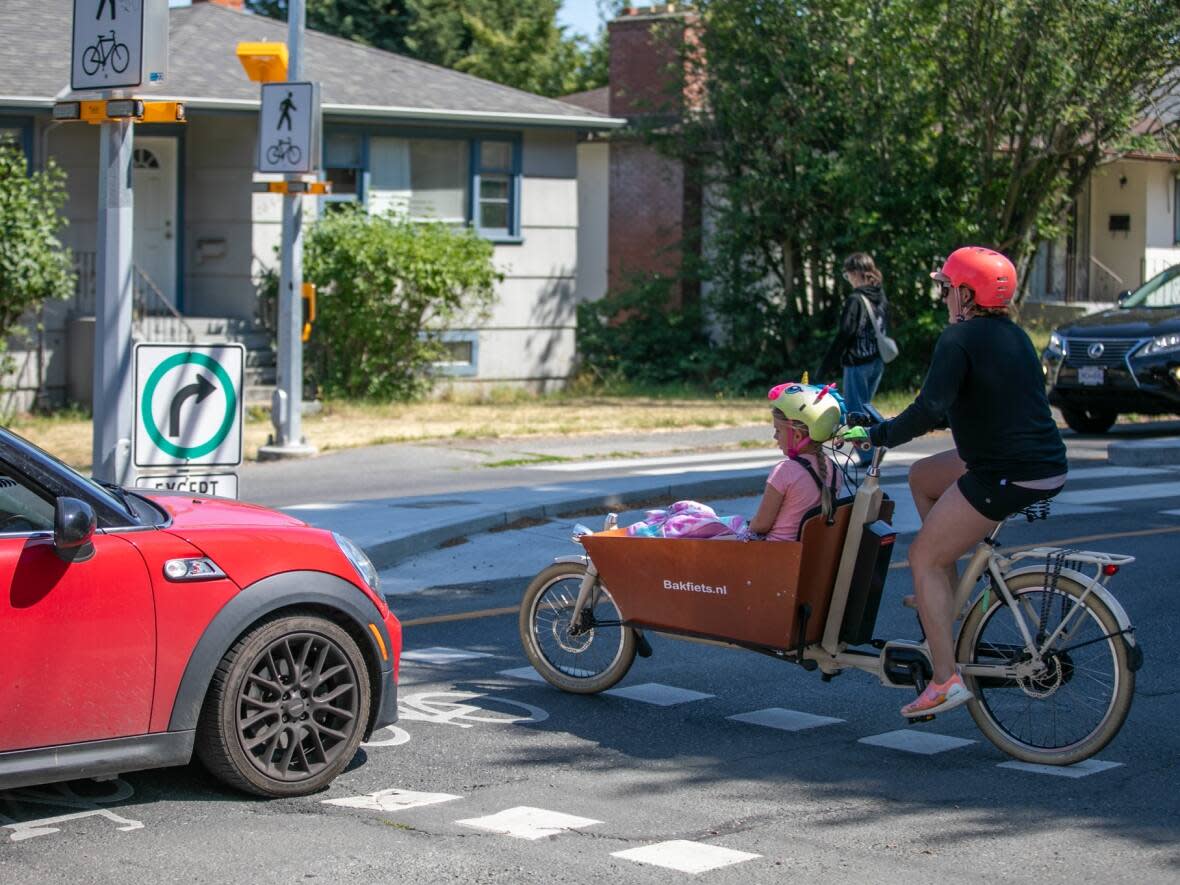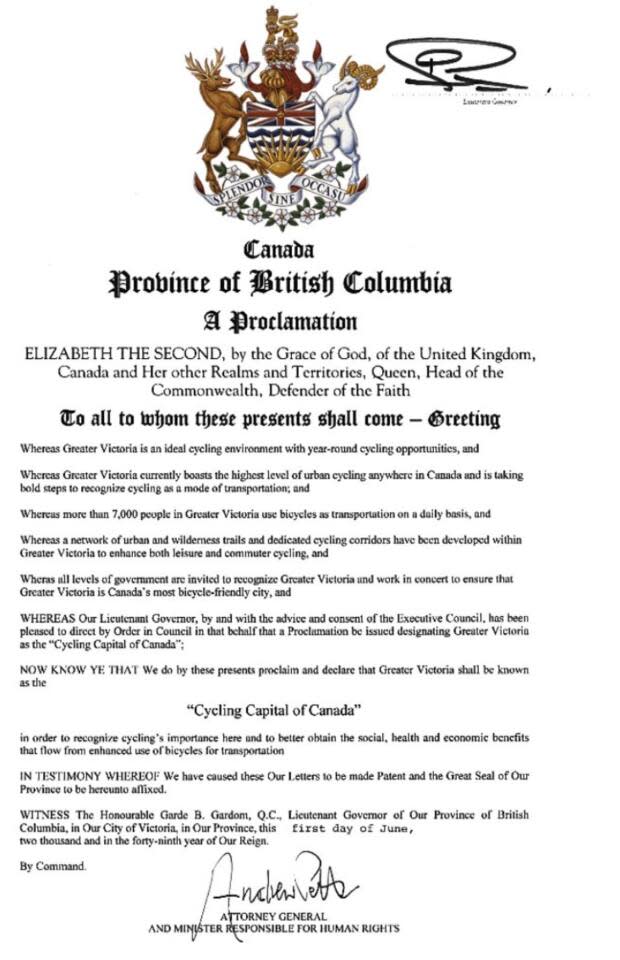Victoria named itself the cycling capital of Canada. Does it deserve the title?

The City of Victoria has again declared itself as the cycling capital of Canada, almost 25 years after it first received the same proclamation from the Queen and attorney general.
It's a step that takes several metrics into consideration, including a 2021 Statistics Canada finding that the city has the highest percentage of people who bike to work in Canada — 5.3 per cent — and the fact that 95 per cent of Victoria residents now live within 500 metres of an all-ages-and-abilities (AAA) bike route.
The declaration, adopted unanimously by city council on Thursday, is also an homage to the same designation given to Victoria in 2000 under authority of Queen Elizabeth II in recognition of the city's "network of urban and wilderness trails and dedicated cycling corridors."
Victoria Coun. Matt Dell hopes the move will entice more cycling enthusiasts to visit the B.C. capital.
"We just want to let the whole country, if not the whole world, know that we still declare ourselves the cycling capital of Canada and it's still a great place to come visit if you want to do some bike tourism," Dell said.

The B.C. capital, located on the southern tip of Vancouver Island, has spent the past eight years and millions of dollars expanding and developing a network of bike lanes. Even so, it does not have the most bike lanes in Canada — that title goes to Kelowna, B.C., which has 283.8 kilometres of cycling infrastructure per 100,000 residents.
But according to Dr. Meghan Winters, a professor in the faculty of health sciences at Simon Fraser University who has been researching active transportation infrastructure across Canada for more than 15 years, length isn't what matters most.
"It's not just [about] how many kilometres, but it's about connecting people to the places that they need to go," said Winters, who in 2022 developed the first cross-country map of bike lanes by classifying cycling infrastructure by safety and comfort.
Ratio of commuters who regularly bike to work
In particular, she said, Victoria's statistic of 95 per cent of residents living within 500 metres of an AAA bike lane — meaning lanes that have some measure of protection, such as bike-only paths, bollards or barriers, or speed-slowing measures for motor vehicles — is top of the line.
"You can safely say that not many cities would meet that kind of standard because it essentially means that there's coverage of bicycling facilities everywhere," Winters said.
"Victoria has an opportunity to do this well because it has a relatively low, small land area."
Montreal's expansion of its bike lane network is another example of a model that "stands out in terms of progress," Winter said. The city plans to build 200 kilometres of secured bike lanes between now and 2027.
Keeping track
The latest available federal data from Statistics Canada shows that nationwide, 26 per cent fewer people were cycling to work in 2021 than in 2016. This is explained partly by the COVID-19 pandemic, and partly due to lack of data, Winters said.
There's no federal program that counts how many bike trips were made for reasons other than work, at a time when many were working from home.
After Victoria, Kelowna had the second-highest rate of bicycle commuting in 2021, at two per cent, followed by Vancouver at 1.9 per cent.
Among the 41 biggest cities, the share of people commuting by bicycle was lowest in St. John's, Saint John, N.B., and Oshawa, Ont., each at 0.2 per cent.
In some cases, municipalities and regions do keep track of bike trips taken for reasons other than work.
Kilometres of cycling infrastructure per 100,000 residents
The Capital Regional District, which includes Victoria and its surrounding municipalities, reported that 13 per cent of all resident trips in 2022 were completed on a bicycle, compared with nine per cent in 2017.
"There's been a broad acceptance of bike lanes and cycling as a reliable and important mode of transportation," Dell said.
"The first bike lanes definitely had a bit of a political challenge getting the pass, but I think people have come to see the benefits of them, and therefore it's a lot easier now to build cycling infrastructure around the region."
An equitable system
In addition to expanding its bike lane network, Victoria introduced a "bike valet" program downtown in 2022 where cyclists downtown can safely park their bikes for free.
The program, which also exists in pilot forms in Toronto, Vancouver, and Calgary, was expanded last year in Victoria because of its popularity.
WATCH | A time-lapse tour along Toronto's pandemic-era bike lanes:
Another factor driving bike use in the region is the growing popularity of e-bikes, e-scooters, and other electronic-assist vehicles.
"One of the strongest cycling advocates we're seeing right now is the senior community who are out cycling to promote good health and [are] enjoying the benefits of the bike," Dell said.
"It's a whole broader group of people rather than just sort of the diehard cyclists of the past."
According to both Dell and Winters, investments in active transportation infrastructure need to continue as part of addressing climate change and to provide options for people who can't or don't want to drive.
"The default place where we've been in North American cities from the outset has been planning around the car and there's so many people who can't drive, and we fail to consider that," Winters said, noting children, seniors, lower income, people with disabilities, and those who choose not to drive for ethical reasons.
"Our whole default system is not an equitable one."
When asked about its declaration as cycling capital of Canada, Winters said Victoria has a lot to celebrate.
"Victoria has been bold," she said. "It set goals and it executed on them."

